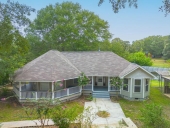
 2
2








James Whitelaw wrote:I haven’t read the thread (at least recently), but this seems a good place to ask a question;
Would placing a heater, ( a hot water radiator or electric fireplace) in an unused brick fireplace be an efficient source of heat.
This is in an old double wythe brick-walled unheated zone 5a structure. We are designing a system of radiators and a hot water heating plant to replace electric space heaters that are used in the shoulder seasons. The structure is winterized and closed during the winter and we want to make it year-round residence. The center of the house is held up by a massive brick pier on which a double fireplace faces out on two first floor rooms. The chimney originally also had four wood/coal stoves feeding into it. A major fire that destroyed the roof occurred sometime about 100 years ago and the fireplaces were sealed and a kerosine heater (long gone) was placed in the kitchen. The chimney is in poor repair above the first floor and is home to a flock of chimney swifts each year
For the sake of this question; We will not be using the chimney for wood fires. My thinking is placing a heat source in the fireplace(s) would be an efficient use of electric heat in that the mass of bricks surrounding the source of heat would retain heat and release it back into the space with very little escaping up the chimney which we would insulate above the flue.
Radiators on exterior walls or under windows work well in keeping a space comfortable, but in many structures a good bit of the heat radiates through the wall or windows (not to mention actual air leaks). Having a 1,500 watt ceramic electric fireplace in an central brick fireplace might be just the thing (and has the advantage of being a diy job).
A related question is would the placement of a hot water radiator in the fireplace be an even better idea? We are designing a hot water system already and certainly would be more economical $$ wise than electric.

 3
3




Some places need to be wild




 1
1




Gardens in my mind never need water
Castles in the air never have a wet basement
Well made buildings are fractal -- equally intelligent design at every level of detail.
Bright sparks remind others that they too can dance
What I am looking for is looking for me too!

 3
3




 3
3





 5
5




 4
4




Thomas Compagni wrote:I have the same thought. I have a rather large cast iron wood stove. It's all cleaned out there's nothing in it I thought about putting a portable electric heater in there and letting the electric heater heat up the cast iron. I don't see why it won't work I think I'm going to try it out just for the hell of it


|
Paper beats rock. Scissors beats tiny ad.
The new gardening playing cards kickstarter is now live!
https://www.kickstarter.com/projects/paulwheaton/garden-cards
|





